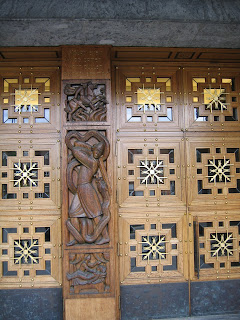Um, Rob.
Oslo's city hall was planned in 1931 but delayed during the Nazi occupation during WWII (Rob also visited the Norwegian Resistance Museum, which was surprisingly more compelling and informative than the Dutch Resistance Museum- when you think WWII, do you ever think of Norway?) and wasn't completed until 1950. In some respects, the building looks like it was built in the 1950s: it's a red bricked building with two office towers and a long rectangular hall. No big deal. But it's really so much more than that. The two office towers are separated by the central hall, which gives the building a grand, castle-like face. Two long, covered halls stretch out towards the street and between them a fountain cascades from under two intertwined swans. Here's a picture from wikipedia:

Note the office towers. The only windows on the front form a long line down the front of each building. On each tower, the ledge forms a 't' with the windows and the statue above. While a cross could mean many things, a religious cross being the most obvious, don't they look more like swords? Anyway, that's Rob's interpretation, backed up by the art in the halls and on the building:

The outer halls are decorated with 16 beautiful wooden friezes, by Dagfin Werenskiold. The friezes are made of pine which has been cut and glued, glazed with linseed oil, paint, and then gilded with gold and silver. Each frieze is about 6 ft by 8ft and weighs a ton. They weren't messing around. Even cooler is the subject matter. The friezes detail Norse mythology. That's Odin above on his eight-legged horse Sleipner. More pictures of the friezes will be in our Flickr page. There are four pillars in front of the doorway, each emblazoned with primitive, golden symbols that look like recreations of Viking art:

And then there's the door:

Does your city hall have a front door with a dragonslayer on it? Didn't think so.
Once you get inside, you see the vast main hall. This room is the largest indoor public space in Oslo, but is most famous for being the room where they hand out the Nobel Peace Prize every year. It's surrounded on all four sides by giant, colorful murals depicting all manner of industry and city history.

The front of the room looks out to the fjord and the room is surrounded on two floors by long halls. The two halls upstairs each have their own four-wall murals, one depicting the life of man and one depicting the history of Norway. The final room is a formal space used for official state meetings and in which the official portraits of the monarchy hang. It also looks out over the fjord.
The office towers are no doubt filled with cubicles (Viking cubicles?) but overall the building really created a real sense of civic and national pride and a genuine embrace of their ancient history. With its powerful façade and grand hall, you could totally picture a Viking bursting through the front door, looking for the right office to register his boat.








